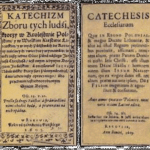
Now that I’ve completed the manuscript edits for The Record of Empty Hall: One Hundred Classic Koans, the section of The Record of Xutang with his unexcelled capping phrases, translated and with comments by yours truly (coming to you in early 2021 from Shambhala), I’m back to doing some dharma study not directly related that project or to what I’m teaching on Vine of Obstacles.
What fell in my cyber lap is a newish (2017) version of The Letters of Chan Master Dahui Pujue, translated by Jeffrey L. Broughton and Elise Yoko Watanabe. The translation also includes annotations from three sources – a great joy for a Zen geek like myself. The most quoted is by the extraordinary Rinzai scholar-monk Mujaku Dōchū (1653-1744), from the Japanese tradition, and the commentary that he worked on for decades, Pearl in a Wicker Basket.
In addition, Broughton and Watanabe offer selections from Notes on the Letters by the great Korean Sŏn master Chin’gak Hyesim (1178–1234), as well as another Korean source, Notes on Plucking Out Difficulties from the Letters, by an anonymous Korean monk.
Dàhuì’s teaching had a particularly powerful and long-lasting effect on Korean Sŏn, so it is especially fitting to include these annotations.
As I work through the text, I plan to blog about it, similar to how I maligned Hakuin’s teaching, but maybe not for a whole year as I did in that series. We’ll see how it goes. First up will be a series of nine posts on the nine themes that Broughton and Watanabe identify in the letters, directed to householders, by the way, who are working with keywords (Chinese, huàtóu, Japanese, watō) like mu in order to have an initial awakening.
For example, the first theme, “you have to do it on your own,” brings up some current issues like the difference between in-person vs. remote work (letters in Dàhuì’s world). Pretty darn fitting for this pandemic world.
And speaking of the pandemic, I find that the fruit of dharma study, reconnecting with deep sanity, incredibly refreshing, even if it is about a controversial figure, and not everybody is always behaving in the most awakened manner. That’s especially the case when dharma study is backed with zazen and engagement.
A bit of background on the controversial Dàhuì
Few if any figures in Zen history have elicited as much admiration and antipathy as Dàhuì (1089–1163). He trained rigorously with several Cáodòng teachers, Línjì teachers in the Huanglong line, and then finally with Yuánwù Kèqín, of The Blue Cliff Record fame, in the Yangqi line.
Dàhuì is reputed to have had eighteen great awakenings and innumerable small awakenings. Here is the report of one of his great awakenings:
“Yuánwù said, ‘Once I asked [Wǔzǔ Fǎyǎn], “What about ‘being’ words and ‘nonbeing’ words which are like a wisteria vine clinging to a tree?”
Wǔzǔ said, ‘You cannot describe it, you cannot depict it.’
I asked further, ‘Suppose the tree falls and the vines die—what then?’
Wǔzǔ said, ‘How important their companionship is to them.’”
The minute I [Dàhuì] heard him raise this, I understood. I said, “I got it!”
Yuánwù said, “I am only afraid that you have not yet become able to pass through the [kōans].”
I said, “Please raise them.”
Yuánwù then raised a series of [kōans]. I cut through them in two or three revolutions. It was like setting out on a trip in a time of great peace—when you get on the road you encounter nothing to stop you.
Yuánwù said, ‘Now you know that I have not deceived you.’” (1)
Additional verifications for Yuánwù’s authorization of Dàhuì comes in the first letter in The Letters of Chan Master Dahui Pujue. Vice Minister Ceng shares this: “I received a letter from your teacher, old Master Yuánwù. He praised you [Dàhuì] by saying that, even though you were a follower who came to him a little late in the day [at age 37], your attainment was singularly magnificent.” (2)
As a teacher, Dàhuì strongly emphasized the keyword method for realizing kenshō and harshly criticized, not always skillfully, the silent illumination practices of some folks within the Cáodòng lineage. For more, see Just Sit or Wake Up? A Tale of Two Old Teachers.
A scholar who focussed much of her career on Dàhuì, Miriam L. Levering, writes, “Dàhuì comes across as a brilliant, clear, inspiring teacher with a deep grasp of Chan practice as lived every day and an extraordinary gift for relating Buddhist philosophy and psychology to ordinary mental and emotional experiences.” (3)
The haters
In a moment, we’ll get to one of the all-time biggest Dàhuì haters, another most-revered Zen master, Dōgen. But Dōgen was not hating singularly. Dàhuì, after all, was sent into exile a couple times so those in imperial circles must also have been among the haters. In addition, Dàhuì made enemies in Cáodòng circles by being too upfront with his criticisms in a very unZen way.
First, this:
“In 1141 the official Li Hanlao, a longtime friend, wrote about the impression Dàhuì made on those who knew him in an inscription (ji) for Mount Jing to commemorate the opening of the new dormitory:
‘The master is the twentieth generation grandson of Línjì. His Way is broad, and those whom it attracts are myriad. His gate is steep, and those who climb it find it difficult [to live up to his strict standards]. His instructions hit the mark, and those who are enlightened under him feel close to him. His discussions are lofty, and those who listen are amazed. But, there are also people who become frightened and disconcerted by his lofty talk. Among his contemporaries, those who doubt him criticize and slander him. I know that there is gossip, defamation, and suspicion circulating about the master and cannot but feel enraged by this.'” (4)
“Enraged” and right there in an inscription for a dormitory! In addition, “gossip, defamation, and suspicion” – kinda odd for a dormitory plaque praising your teacher. What was going on that prompted Li Hanlao to lay that out there like that? I don’t know, but sounds like something someone would say in a passive-aggressive way on social media, and after pushing “send,” regret it.
Among those who were still defaming Dàhuì about one hundred years later was Dōgen. Yup. The founding Sōtō ancestor. Early in his career, though, Dōgen had praised Dàhuì thusly:
“Once Zen master [Dàhuì] had a swelling on his buttocks [apparently hemorrhoids]. A doctor took a look at it and said it was critical. [Dàhuì] asked, ‘Is it so serious that I might die?’
The doctor replied, ‘Possibly.’
[Dàhuì] said, ‘Well, I am going to die anyway, so I shall practice zazen that much harder.’
He pushed himself to sit and, eventually the swelling broke and went away. The mind of this ancient master was like this. When he got sick, he sat zazen all the more. Students of today, despite being well, don’t let up practicing zazen!'” (5)
Disclaimer: Neither the author nor anyone at Patheos (as far as I know) has actually undertaken this practice, nor do we recommend sitting on your hemorrhoids until they burst. Do not try this at home.
Anyway, later on, Dōgen had a much less flattering appraisal of Dàhuì, especially in “Self Realization Samadhi” (“Jishō zanmai”自證三昧) where he launches into a five-page rant, I believe it is the longest of the many rants in Shōbōgenzō, about what a faker Dàhuì was, how he shopped around for transmission, was seen as a total one-chopstick job by every teacher he ever had, and never really had a final awakening.
Here’s just a bit of Dōgen’s summary:
“But from beginning to end, [Dàhuì] did not seem to have a unique point of understanding. He did not show any point of understanding in his own lectures or talks. Know that the recorder of his words mentioned that he had had divine enlightenment or dharma of great ease and bliss, but did not admit that he had actually had realization. Do not take him seriously. He was merely a student. If we take up Yuánwù’s words and examine senior monk [Dàhuì], we see that he did not have wisdom close to that of his teacher and he did not have wisdom equal to his teacher. Furthermore, it seems that he had never dreamed of wisdom beyond his teacher. Thus, know that [Dàhuì] had less than half the capacity of his teacher. He only memorized lines from the Avatamsaka Sutra and the Shurangama Sutra and spoke about them. He was not yet the bones and marrow of buddha ancestors. (6)
Notably, Yuánwù, who Dōgen praises highly, seemed to have disagreed. Yuánwù gave Dàhuì transmission, after all, and regarded his “attainment was singularly magnificent,” if Yuánwù was a great teacher, as Dogen acknowledges, Dōgen, who didn’t know Dàhuì, seems to be just mouthing sectarianism. Gossip, defamation, and suspicion!
Even the great Dōgen, of course, had his issues, and here he reinterprets Dàhuì’s biography in a blatantly self-and-his-lineage serving way.
The whole five pages in “Self Realization Samadhi” is also notable in that Dōgen focuses his Dàhuì take-down on Dàhuì’s alleged lack of awakening, something that many in contemporary Sōtō Zen do not regard as important, and they support that misunderstanding by selectively citing Dōgen. Some argue that Dōgen didn’t have a definitive awakening. If he hadn’t, or if awakening wasn’t important for Dōgen, why go on for five pages? And Dōgen never even mentions Dàhuì’s most important contribution – culling out and highlighting the keyword method.
Conclusion
Love him or hate him, Dàhuì’s teaching had legs. Every kōan student for the last 1,000 years that received and embodied mu, owes him a debt of gratitude.
For a concise summary of his contributions, I turn to Miriam L. Levering:
“Dàhuì formulated and popularized the form of [kōan] study called “looking into and observing a saying,” the saying being a word, sentence, or phrase that crystallizes a specifically chosen [kōan] problem. This method of [kōan] study is sometimes called “inspecting the [keyword],” or in Chinese, kan huàtóu. This method of [kōan] study remained at the heart of most Chinese Chan training not only for the rest of the Song dynasty but also for all the succeeding centuries in China, Korea, and Japan.” (7)
(1) Steven Heine, ed., Zen Masters, “Dahui Zonggao (1089–1163): The Image Created by His Stories about Himself and by His Teaching Style,” Miriam L. Levering, 104.
(2) The Letters of Chan Master Dahui Pujue, trans. Jeffrey L. Broughton and Elise Yoko Watanabe.
(3) Levering, op cit., 111.
(4) Levering, op cit., 110.
(5) Shōbōgenzō Zuimonki, trans. Shohaku Okumura, 187.
(6) Eihei Dōgen, Treasury of the True Dharma Eye, trans. Kazuaki Tanahashi, 704.
(7) Levering, op cit., 91.
Dōshō Port began practicing Zen in 1977 and now co-teaches with his wife, Tetsugan Zummach Sensei, with the Vine of Obstacles: Online Support for Zen Training, an internet-based Zen community. Dōshō received dharma transmission from Dainin Katagiri Rōshi and inka shōmei from James Myōun Ford Rōshi in the Harada-Yasutani lineage. Dōshō’s translation and commentary on The Record of Empty Hall: One Hundred Classic Koans, is now available (Shambhala). He is also the author of Keep Me In Your Heart a While: The Haunting Zen of Dainin Katagiri. Click here to support the teaching practice of Tetsugan Sensei and Dōshō Rōshi.












